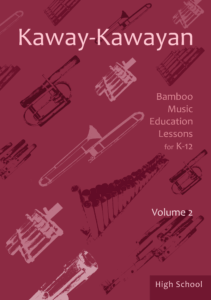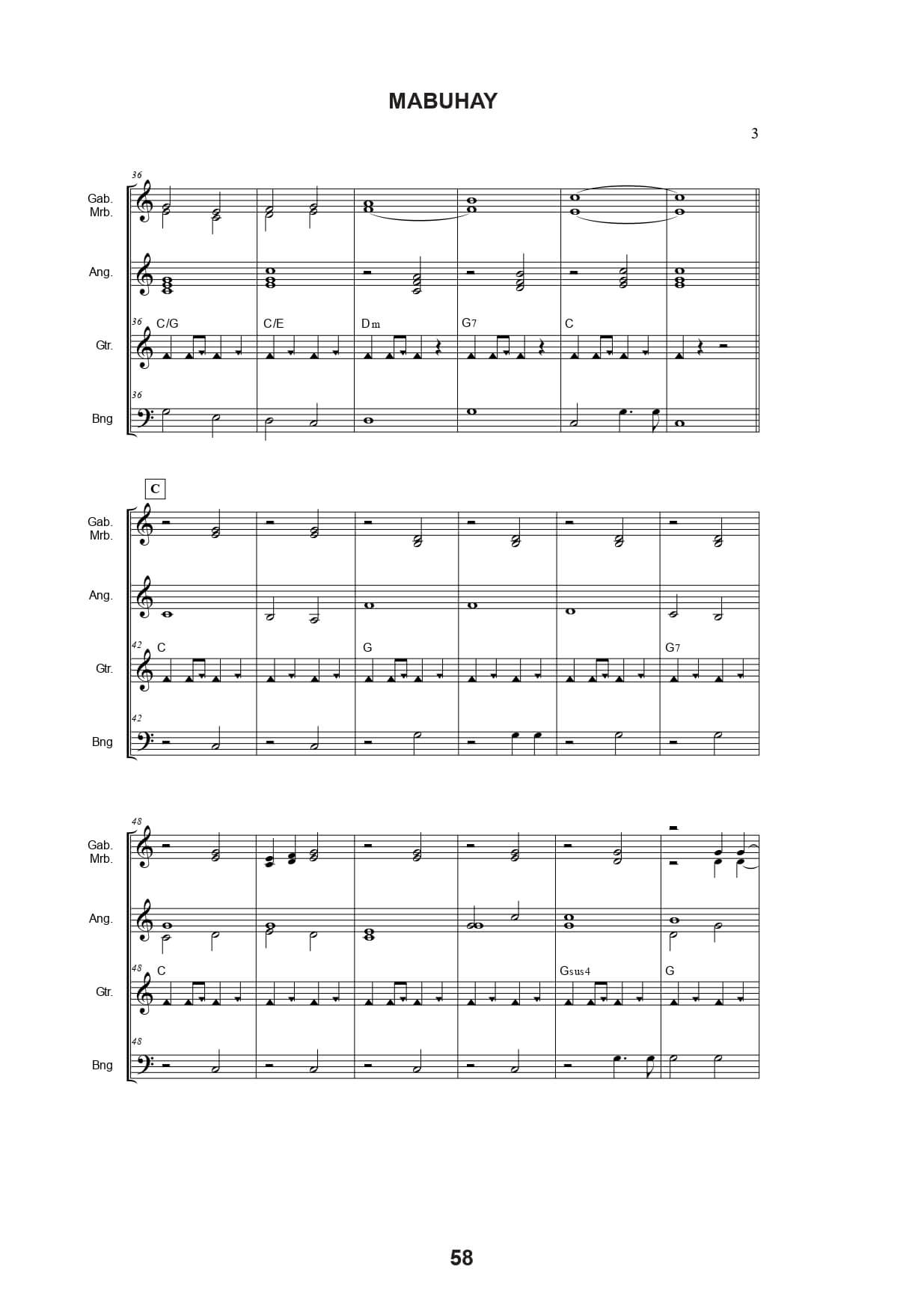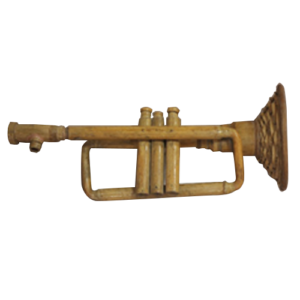Highschool Module
MABUHAY REHEARSAL PLAN
Background
Title:Mabuhay
Composer: Tirso Cruz Lyricist: James King Steele
Arranger: Genaro Cesar Edilo Jr. (2014)

Lyrics
Mabuhay
Sweden answers skoll England says here’s cheerio And lifts the flow-ing bowl Japan shouts her ban-zai But out in the Phil-ip-pines You hear this cheer-ry cry.
Chorus
We say Ma-bu-hay We say Ma-bu-hay Under the blue sky
When our friends sit by Gree-ting a farewell
A toast that will wear well We lift our glass-es and say Ma-bu-hay!
Gol-den days of trop-ics Where the blue waves toss Gleam like gorgeous jewels Neath the South-ern Cross Soft brown eyes are spark-ling Lus-cious lips come near
If you lis-ten close-ly This is what you hear.
Chorus
Sunny lands of laughter Set in South-ern Seas I long to be back again
Be-neath your man-go trees When I’m in the is-lands Where I’m going to stay
We will raise a brim-ming glass.
The melody for “We Say Mabuhay” was composed by Tirso Cruz in the 1930s, with lyrics by James King Steele. Cruz was the mainstay conductor of The Manila Hotel Orchestra when the marching hymn was first played on May 16, 1931, at The Manila Hotel. Cruz was the most popular and well-paid orchestra conductor in Manila at the time.
“We Say Mabuhay” is customarily performed as the honors music for the President of the Philippines during the Philippine presidential inauguration following the oath of office of the incoming President. The soldiers of the Armed Forces of the Philippines (AFP) honor the new commander-in-chief with their first 21-gun salute. It is also played upon the entrance or approach of a current President of the Philippines.
The word “Mabuhay,” which appears heavily in the song’s title and lyrics, is a Tagalog greeting that means “long live.”
A. MATERIALS 
Audio tracks – Scan QR code on the right
Sheet music – Mabuhay arrangement by Genaro Cesar Edilo Jr.
B. GUIDE TO THE PIECE
The piece has three major parts. In part A, m 10–25, the gabbang and marimba play the melody and second voice, sometimes the counterpoint. The angklung plays the chords in half note on the third beat of the measure. In part B, m 26-41, the angklung will play the melody and second voice while the gabbang and marimba play the chords in half notes. These changes will also be observed in parts K and D.
In part E, m 74, the gabbang and marimba play the melody and second voice until m 81. On m 82–89, the angklung will play the melody. On part G, m 90–97, the gabbang and marimba will first play the melody, then the melody will be played by the angklung on m 98–104. The guitar plays the rhythm and the bumbong plays the bass part throughout the piece.
Measures 105–108, the ending part, give a breathtaking emotion that ends with a strong downbeat.
- DAY1
| Time Allotment | Material | Instrument | Measures | Objective | Activity | Assessment |
|
Intro, Part A, and B (m 1–41) |
Familiarize with | Analyze and scan the | Students should be | |||
| 10
minutes |
As a group | the various components of the piece. | piece. The teacher will facilitate and explain the piece. | able to spot section markers (A, B, K, D, etc.) | ||
| Develop sight | ||||||
|
10 minutes |
All sections |
reading skills.
Practice their parts |
Members can sing, chant, or play their part. | The members will evaluate their own sound. | ||
| Mabuhay | individually | |||||
| 10 | gabbang |
Check the part on each section to correct and improve rhythm, tempo, and dynamics. |
Sing/chant and clap the rhythmic notation. Play their instrument.
Note: The teacher will observe and listen. If there are parts that should be corrected, the |
Watch out for rhythmic accuracy and correct tune in singing. |
||
| minutes | ||||||
| 10 | marimba | |||||
| minutes | ||||||
| 10 | angklung | |||||
| minutes | ||||||
| 10 | bumbong | |||||
| minutes | and guitar | |||||
|
10 minutes |
All sections |
Ensemble playing |
Playing as a group |
Coordination and balance should be emphasized in ensemble playing. | ||
|
BREAK |
||||||
|
Mabuhay |
Part K and D (m 42–73) |
Develop sight | ||||
|
10 minutes |
All sections |
reading skills.
Practice their parts individually |
Members can sing, chant, or play their part. | Watch out for rhythmic accuracy and correct tune in singing. | ||
| 10 |
Check the part on each section to correct and improve rhythm, tempo, and dynamics. |
Sing/chant and clap the notation.
Play their instrument. Note: The teacher will observeand listen. If there are parts that need to be corrected, the teacher will demonstrate it to the students. |
Rhythmic accuracy, good tone, and correct pitch is important to note. |
|||
| minutes
10 |
gabbang | |||||
| minutes | ||||||
| 10 | marimba | |||||
| minutes | ||||||
| 10 | angklung | |||||
| minutes | ||||||
| 10 | bumbong | |||||
| minutes | and guitar | |||||
| The group listens | ||||||
| 10
minutes |
All sections | Ensemble playing | Playing as a group | for good ensemble tone, timing and
coordination, and |
||
| balance. | ||||||
DAY 2
| Time Allotment | Material | Instrument | Measures | Objective | Activity | Assessment |
|
Part E and G (m 74– 110) |
Develop sight | |||||
|
10 minutes |
All sections |
reading skills.
Practice their parts individually. |
Members can sing, chant, or play their part. | Rhythmic accuracy, good tone, and correct pitch is important to note. | ||
| 10 | gabbang |
Check the part on each section to correct and improve rhythm, tempo, and dynamics. |
Sing/chant and clap the notation.
Play their instrument.
Note: The teacher will observe and listen. If there are parts that need to be corrected, the teacher will demonstrate it to the students. |
Rhythmic accuracy, good tone, and correct pitch is important to note. |
||
| minutes | ||||||
| 10 | marimba | |||||
| minutes | ||||||
| 10 | angklung | |||||
| minutes | ||||||
| Mabuhay | ||||||
|
10 |
bumbong |
|||||
| minutes | and guitar | |||||
| 10 | The group listens | |||||
| minutes |
All sections |
Whole piece |
Ensemble playing |
Playing as a group |
for good ensemble tone, timing and coordination, and balance. | |
|
15 minutes |
References:
Canciones de Filipinas YouTube Channel. “Mabuhay March” – Honors Music for the President of the Republic of the Philippines. Accessed March 15, 2022. https://www.youtube.com/watch?v=AM9HiR3ZEPs.
Philippine Official Gazette. “The Transition.” Accessed June 29, 2022. https://www.officialgazette.gov.ph/featured/the-transition/.
Philippine Star. “Tirso Cruz: Composer of Mabuhay, My Philippines.” Accessed March 15, 2022. https://www.philstar.com/entertainment/2017/10/28/1753407/tir-so-cruz-composer-mabuhay-my-philippines.
Science in a creative industry.
The DOST-FPRDI has a Bamboo Musical Instruments Innovation R&D program aimed at improving the quality of locally-made bamboo musical instruments (BMIs) through science and innovative technologies. The program seeks to standardize the production of selected BMIs, develop prototype designs, analyze raw material sources and existing markets, and build a BMI processing facility. In addition, the program aims to document the ethnocultural story behind several BMIs and identify the bamboo species used in BMI production to promote public awareness and appreciation of the cultural importance of these musical instruments. The program is a collaboration with the University of the Philippines and Philippine Normal University for teaching modules and analyzing sound quality and standardization of BMI design. The DOST Grants-in-Aid program provides funding.
PhBMI
















